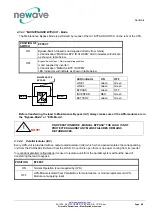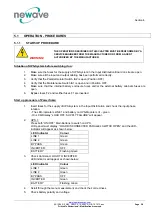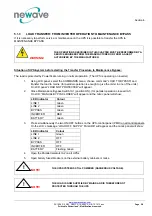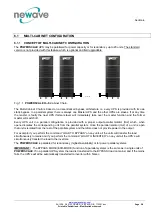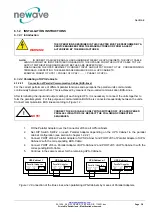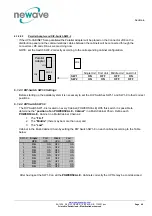
Section-7
www.newavenergy.com
04-1206_S7_NW_OPMPS_10-50kVA_GB_110201.doc
Page 2/4
Printed in Switzerland – Modifications reserved
7.1 MAINTENANCE
7.1.1 INTRODUCTION
WARNING!
THE OPERATIONS DESCRIBED IN THIS CHAPTER MUST BE PERFORMED BY A
SERVICE ENGINEER FROM THE MANUFACTURER OR FROM A AGENT
AUTHORIZED BY THE MANUFACTURER.
To ensure an optimum operation of the
POWERSCALE
and a continuous and efficient protection of the connected
load it is recommended to check the batteries every 6 months, depending on the ambiance temperature.
7.1.2 USER
RESPONSIBILITIES
There are no user serviceable parts contained within the UPS so the maintenance responsibilities of the user are
minimal. To maximize the useful working life and reliability of the UPS and its batteries, the environment in which the
UPS operates should be kept cool, dry, dust and vibration free. The batteries should be hold fully charged.
7.1.3 ROUTINE
MAINTENANCE
The UPS is designed to receive regular preventative maintenance inspections. These preventative maintenance
inspections are essential to ensure that both the useful working life and the reliability of the UPS are maximized.
When the UPS is commissioned, the commissioning field service engineer will attach a service record book to the
front of the UPS and this will be used to record the full service history of the UPS.
Preventative maintenance inspections involve working inside the UPS, which contains hazardous AC and DC
voltages. Only NEWAVE trained or agreed service personnel and authorized field service engineers are fully aware
of all of the hazardous areas within the UPS.
During a preventative maintenance inspection the field service engineer will carry out the following checks:
•
Site/enivrement
conditions;
•
Integrity of electrical installation;
•
Cooling
airflow;
•
Rectifier operation and calibration;
•
Inverter operation and calibration;
•
Static
switch
operation;
•
Battery
status;
•
Load
characteristics;
•
Integrity of alarm and monitoring systems;
•
Operation of all installed options
7.1.4 BATTERY
TEST
The battery test takes approx. 3 minutes and should be performed only if:
•
there are no alarm conditions
•
the battery is fully charged
•
mains is present.
The battery testing can be carried out independently of the operation mode (OFF-LINE or ON-LINE) and whether
or not the load is connected. The battery test procedure can be performed from the UPS front panel. See
“Operation”
Section-4, Paragraph 4.1.
4

